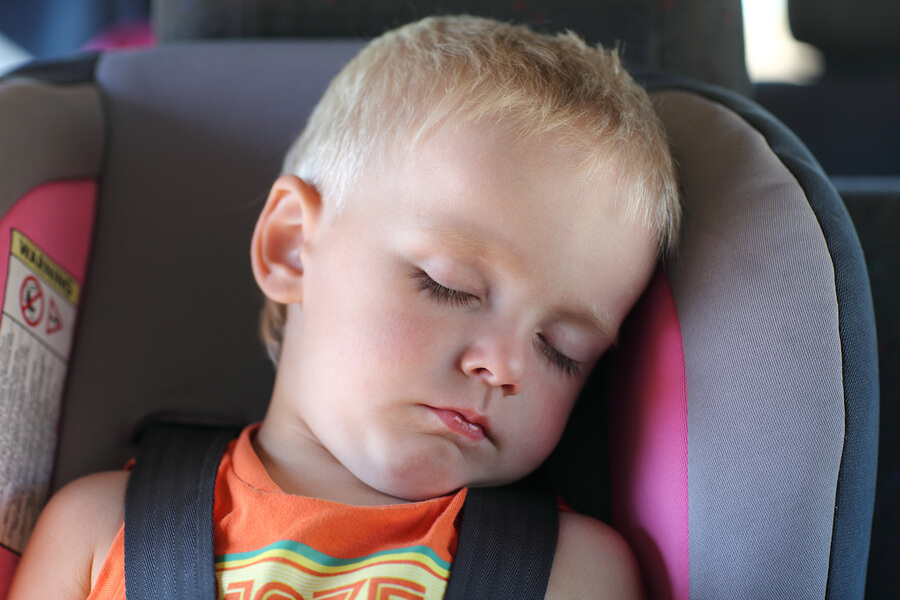
Don’t Knowingly Leave a Child in the Car

Don’t Knowingly Leave a Child in the Car
Don’t be tempted to let your dozing child continue sleeping in the car after you have arrived at your destination — not even in your own driveway. Even if it’s 60 degrees outside, a car can still reach temperatures over 110 degrees inside. Cars can heat up 20 degrees in 10 minutes, and rolling down the windows or parking in the shade does little to keep a car interior cool on a hot day. Even if it’s a cloudy day, never leave your child unattended in the car. Children’s body temperatures rise much more quickly than adults, and they can suffer from heatstroke with a body temperature of 104 and die with a temperature of 107 degrees.
Use Reminders and Double-Check

Use Reminders and Double-Check
When parents are frazzled or overtired, or when they stray from their normal routine, they’re more likely to forget a quiet child in the backseat. Create a reminder for yourself that your child is in the backseat. Try these strategies:
- Put an essential item, such as your purse or briefcase, next to your child’s car seat rather than in the front seat.
- Place a “baby on board” or “look before you lock” sign or note on your dashboard or front passenger seat when you place your child in the car seat.
- If your family is following a new routine, or someone different (such as your spouse, a grandparent, neighbor, or babysitter) is driving your child to daycare, always check in with the daycare or person who did the drop-off to ensure your child reached the destination.
Keep Your Car and Trunk Locked

Keep Your Car and Trunk Locked
Whenever your car is not in use, keep it locked, including the trunk. Be sure your car keys are out of sight and reach from young children. Keep a close eye on your child during outdoor playtime, and teach her not to play in your vehicle or trunk. High temperatures and poor ventilation make the trunk an especially dangerous place. Check your car’s trunk right away if your child is missing. If your car is older and doesn’t have a “glow-in-the-dark” trunk release, consider having one installed.
Take Action if You See a Child at Risk

Take Action if You See a Child at Risk
The National Highway Traffic Safety Administration (NHTSA) urges you to offer assistance if you see a child alone in a car, and get help right away if you notice signs of heatstroke. “Don’t worry about getting involved in someone else’s business — protecting children is everyone’s business,” according to the NHTSA. Besides, “Good Samaritan” laws offer legal protection for people trying to help in an emergency. The NHTSA offers these tips if you see a child alone in a vehicle:
- Don’t wait more than a few minutes for the driver to return before taking action.
- If the child is in distress or not responsive, call 911 immediately, get the child out of the car, and spray the child with cool water (not an ice bath).
- If the child is responsive, stay with him until help arrives, and have someone else search for the driver or ask the store/facility to page the car owner.
Don’t Forget Pets

Don’t Forget Pets
In addition to children, pets are at high risk of heat stroke when left alone in a car. Only bring your pet in the car with you when it’s absolutely necessary, and keep in mind that rolled-down windows and shady parking spaces won’t necessarily prevent heatstroke. People for the Ethical Treatment of Animals (PETA) advises watching for signs of heatstroke in dogs left unattended in cars: restlessness, thick saliva, heavy panting, lethargy, dark tongue, clumsiness, vomiting, or bloody diarrhea. If you notice any of these symptoms, call animal control and tell them it’s an emergency. Remove the dog from the hot car, bring it into an air-conditioned car or building, and contact a veterinarian immediately.
Know that It Can Happen to Anyone

Know that It Can Happen to Anyone
Many of us hear the horrible stories about hot car deaths and think that we could never do such a thing. After all, leaving a little one alone in a hot car can have devastating consequences, including severe injury or death of the child, and possible jail time for the forgetful or neglectful parent or caregiver. But parents who have faced this devastating reality never thought it could happen to them, either. “Many cases involved what might be called community pillars: dentists and nurses; ministers and college professors; a concert violinist; a member of a county social services board; a NASA engineer,” the Associated Press reports. The heartbreak of hot car death affects mothers and fathers of all ages, ethnicities, education levels, and socio-economic backgrounds, according to The Washington Post. “It happened to a rocket scientist.”
Check out these additional resources:
- SaferCar.gov
- KidsandCars.org
- NoHeatStroke.org





